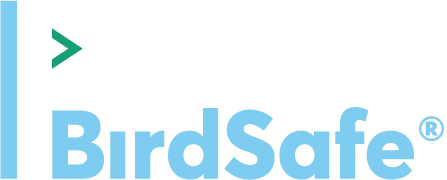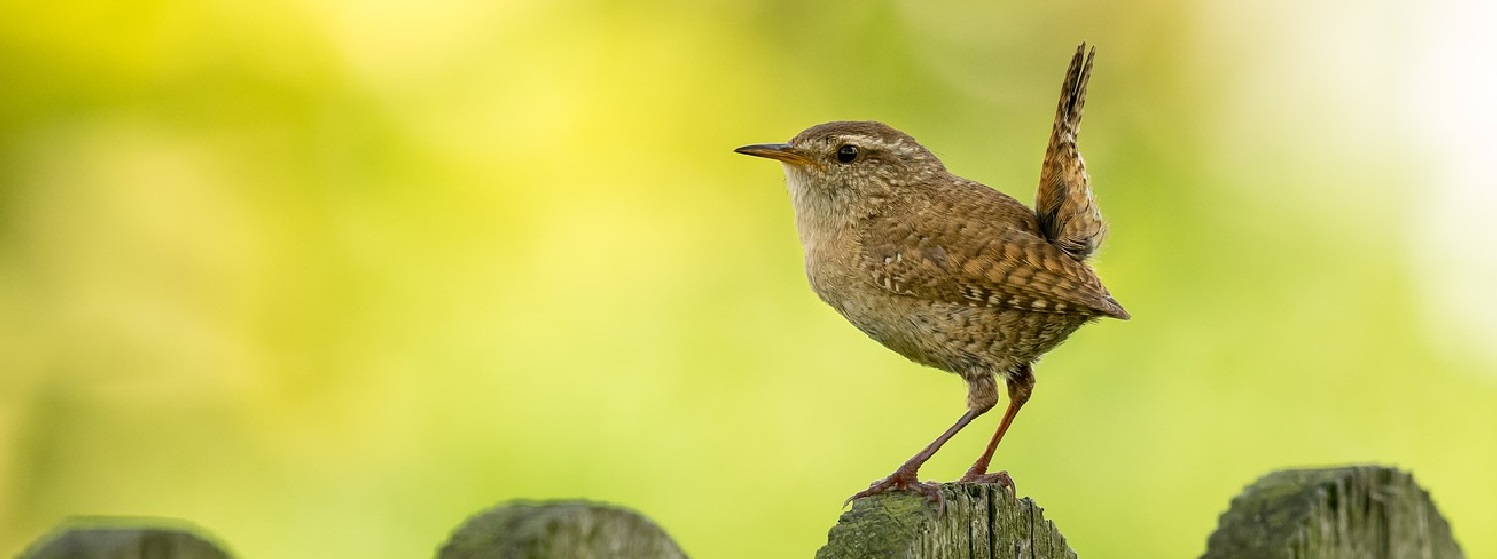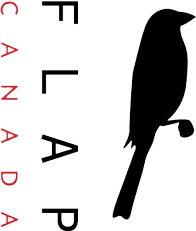What is the Global Bird Collision Mapper?
The Global Bird Collision Mapper (GBCM) is an online geo-mapping tool designed for registered users to report the locations of bird collisions with buildings. The details of each report can be seen by anyone who visits GBCM.
Why use the Global Bird Collision Mapper?
The Global Bird Collision Mapper is an international bird collision database designed to help better understand where and to what degree collisions are occurring. Your participation in Global Bird Rescue will not only help demonstrate the magnitude of the problem, it will help inspire further development of effective preventative measures and standards designed to protect bird species.
How do I enter a collision record into the Mapper?
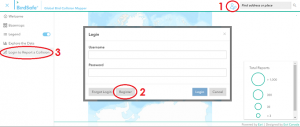
Do I need to identify a bird species in my Mapper report?
You are not required to identify individual bird species to report collisions. In fact, we discourage entering a species name unless you are skilled at bird identification. We do however encourage including a photo of the bird for the purpose of possible identification at a later time.
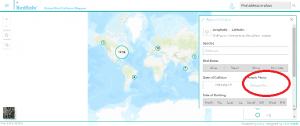
If you wish to familiarize yourself with bird species to aid with identification, there are several excellent bird identification guides available for purchase at your local bookstore. The Peterson Field Guide to the Birds of North America and National Geographic Field Guide to the Birds of North America are both good guides. In addition, the Cornell Lab of Ornithology has a phone app called Merlin Bird ID, which is able to identify the possible species of a bird with a photo.
Why can’t I locate the building on the map where I found the bird?
Explore different basemaps when you can’t locate a building on the default topographic map. The satellite map tends to be the most up-to-date map. The option for basemaps can be found in the navigation dropdown.
How do I access my reports?
To access your collision reports, you can either locate your report on the map, or search for your entries under the “Explore the Data” under the menu icon. Enter your username into the “From a specific observer” bar. Once you have pressed enter, your reports will show up on the map and you can either click on them individually or scroll through them in the total reports.

How do I edit or delete a report?
Currently you can only edit one of your entries within 7 days of creating it. Once you have found the specific report you want to edit on the map, you can select the report and click the small edit button in the bottom left corner.
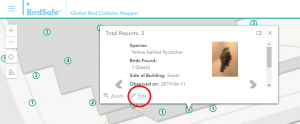
If you accidentally made an entry and want it deleted, simply email mapper@flap.org with the details of the specific report and we will delete the record for you.
How do I create a group on the Mapper?
To create a group in the Bird Collision Mapper, simply fill out the group request form at the bottom our GBR Manual and email it to mapper@flap.org. We will create the group and add members for you. Once individuals are registered as part of a group, they can submit reports independently or as a group entry. Make sure to indicate you want to create a group in the subject line of your email.
Why am I not able to edit my collision records?
You have up to 1 week (7 days) to modify a collision record after initial entry.
Why are my collision entries not showing in the correct location?
To ensure the accuracy of a collision location, locate the building on the map where you found the bird. This can be done in one of two methods:
- enter the address of the building into the Find address or place box in the upper right-hand corner of your screen.

OR
- click the Use my location icon at the top left-hand corner of the Report Collision form. Click this icon 2 or 3 times to assure accuracy.

Once you have located the building on the map, identify the side of the building where the bird was found and zoom in to a closer magnification before clicking on the map to enter you record.
Why can’t I find the building on the map where I found the bird, even after I press the ‘Find my location’ icon?
You will find that pressing the ‘Find my location’ icon isn’t always accurate. To ensure you are entering a collision record at the correct location, consider entering the building address into the ‘Find address or place’ field located in the GBCM header.
Why am I not receiving my verification code to register with the GBCM?
When registering as a GBCM user, it can take up to 20 minutes to receive a verification code. Be sure to check your junk mail if the verification code doesn’t arrive.
How do I join a group?
You can request to be part of a group by emailing mapper@flap.org and providing your account name and the name of the group you are trying to join. We will add you to that group and you will then be able to add entries with that group.
Can I be part of more than one group?
Yes! Once you have an account, you can be part of multiple groups.
Why do I need to include the side of a building in a report?
The side of a building is important because a building can have multiple sides and facades. By indicating which side of the building the bird struck, you are helping to identify the highest collision risk areas for birds.
Does FLAP Canada have a Board of Directors?
Yes, FLAP Canada is a registered Canadian charity with a Board of Directors. The Board directors bring a variety of talents, experiences and expertise to the governance of FLAP Canada, and meet monthly to provide oversight for effective organizational management.
How can I join FLAP Canada’s Board of Directors?
Volunteer Board service offers an excellent opportunity to contribute to our cause, while sharing your expertise, talent and ideas for governance, revenue generation, research and administration. For more information, contact (416) 366-3527 or email flap@flap.org.
How is FLAP Canada funded?
FLAP Canada is a registered Canadian charity (No. 140746736RR0001 ) funded by individuals, foundations, corporations, and various levels of government. Other sources amount to less than 1% (according to Canada Revenue Agency charitable allowance) from fees for service from consulting, sale of merchandise, and income from earned interest.
Where does my/our donation go?
Your donation directly supports the underpinnings of our mission: promotion and education, citizen science, rescue and rehabilitation, and advocacy. It also includes fundraising and administration costs. For more details, our annual financial statements are posted online in the Canada Revenue Agency Directorate listing.
How will my donation help FLAP Canada?
Your donation funds: public awareness and education campaigns (residential and commercial); in-field volunteer patrols and monitoring, and; lobbying and public advocacy, to name a few.
May we designate our donation for a specific purpose or special mention?
We are a small charity, and every dollar of your gift goes to support our mission. In today’s world, with greater emphasis on technology, FLAP does require IT (information technology) needs such as application development, website redesign and web-enabled tools to enhance citizen science and engagement activities that would help us advance our organization. Please call (416) 366-4527 or email flap@flap.org to inquire about specific appropriation.
You may also designate monthly giving, tribute gifts, gifts in memoriam or planned gift giving. Click here to learn about our donation plan options, or call (416) 366-4527 or email flap@flap.org.
I want to donate! How do I do that?
Thank you for your generous offer to support us. You may send a cheque or money order, made payable to FLAP (Fatal Light Awareness Program) Canada (or FLAP Canada), c/o Box 199, 123 Queen Street West, Toronto, ON, M5H 3M9. Alternatively, it may be more convenient to send a secure online donation via canadahelps.org. Or call us at (416) 366-4527 (FLAP) or email flap@flap.org.
How can we start an in-field volunteer monitoring program in our city, similar to what FLAP does?
That would be awesome! Some thought starters for you: See about partnering with local naturalist groups, bird banders or other interested people. Contact local city councillors to discuss the possibility of starting a Lights Out public awareness campaign in your city during Earth Hour or spring and fall migration seasons. Ask your local councillor what resources they can offer, such as office space, financial support, rescue equipment, or transportation for injured birds. If you’re in a bird-friendly community, enlist your neighbours and friends to ramp up a Neighbourhood Bird Watch. For more ideas, contact us at (416) 366-3527 or email flap@flap.org.
Do birds really matter?
Yes, birds matter. Birds provide a critical link in native ecosystems. They pollinate plants, distribute seeds, and eat billions of insects every year. These behaviors help to maintain fertile agricultural land, healthy wetlands and lush forests. Birds play a vital role in the ecological and biological interdependent processes that are essential to life itself.
Birds also provide an accessible connection to the natural world, especially for urbanites. It is hard to imagine a day without the rejuvenating sound of bird song. Their beautiful bird song, remarkable feathers and interesting flight patterns immeasurably enrich our lives, inspiring design, architecture, culture, art, music and poetry.
Equally important is the contribution birding is to local economies. The last survey, carried out by Statistics Canada, on behalf of the Canadian Wildlife Service, indicated 14.5 million Canadians participated in wild-life-related recreation activities. In a 2011 US Fish and Wildlife survey on birding in the United States, 71.8 million birders spent $17.3 billion on trip expenditures and $27.2 billion on equipment.
When do birds migrate?
Birds migrate in the spring to their summer nesting grounds in northern Canada and the Boreal Forest. In the fall, they fly south, back to their winter feeding areas. Depending on the species, winter feeding areas might be anywhere from southern Canada, to the southern tip of South America.
Migration is triggered by an increase (in the spring) or a decrease (in the fall) in the phototropic period: the number of hours of daylight. The onset of both spring and fall migration fluctuates mildly due to climate and food sources, but generally spring migration begins in mid-March and continues until the beginning of June. Fall migration begins in early August and continues until mid-November.
What should I do if I find a baby bird?
Some tiny birds, such as wrens and warblers, look like baby birds even though they are mature. If you find a bird sitting under a window and it does not move when you approach, most likely the bird is an adult bird that has hit the window. Follow the above instructions on what to do when you find an injured bird.
If you find a featherless baby bird, and you know where the nest is, place the baby bird back in the nest. The parent birds will not smell your scent and reject the bird. If you cannot find the nest, make one out of a small basket or flowerpot lined with leaves or dry grass. Place the substitute nest close to the area where you found the baby bird.
If the baby bird is feathered and has just left the nest, it may be on the ground waiting for its parents. The best thing to do is leave the bird for the parents to care for and feed. If you believe the bird is in danger from roaming cats or other predators, place it high up on a tree branch where it will be safe. If you are still concerned (perhaps the parents have not returned for a long time) contact your local wildlife rehabilitation facility, such as Toronto Wildlife Centre, for advice.
What should I do if I see an injured or dead bird that has collided with a building?
If you see a dead or injured bird that has collided with a building, pull on some gloves (or use other protective barriers) and rescue the bird or remove the body before predators do. Report your finding to FLAP by either social media or phone our monitored hotline at (416) 366-3527. Reporting a dead bird is a grim task, but it helps us track and assess whether any particular intersection or property is a hot zone. Statistical kill data in our database has also been used for ornithological and environmental research.
I want to volunteer with FLAP. What opportunities are there for me to consider?
Thank you for considering a rewarding volunteer opportunity that helps keep migratory birds safe. We rely on volunteers for many tasks, including event support; in-field bird rescue patrols; driving injured birds to wildlife rehabilitation centres; writing services; fundraising campaigns; translation; database; and, office work, to name a few. Please contact our volunteer program coordinator, Paloma Plant, who can coordinate an assignment that suits your interests and skills; pplant@flap.org or call 416-366-3527.
Will I get training as a volunteer?
Yes. The extent of training depends on your assignment with FLAP Canada.
Is my health at risk if I touch a wild bird?
Birds are much more likely to contract diseases from humans than the other way around. For this reason, and to protect yourself from any remote health risk, we suggest that you wear hand protection such as latex or vinyl gloves, and wash your hands before and after handling birds. This is simply good practice when handling any wildlife or unknown plant material or matter the bird may have been exposed to.
Is West Nile Virus a concern for FLAP volunteers doing in-field monitoring?
The risk of contracting West Nile Virus from birds is minute. The best way to protect against West Nile Virus is to protect against mosquitoes. Bites from infected mosquitoes are the main transmission route of West Nile Virus to humans. Even then, the chances of you becoming extremely ill from the bite of an infected mosquito are extremely small: less than 1%.
You can always use gloves when handling live or dead birds, and follow-up with thorough hand washing or the use of hand sanitizer. This is simply good practice whenever handling birds or any other wildlife or unknown plant material or matter the bird may have been exposed to. For information and up-to-date facts about West Nile Virus, visit Public Health Agency of Canada.
For information and up-to-date facts about West Nile Virus, visit Public Health Agency of Canada.
Is Avian Flu (HPA1, H5N1) a concern for FLAP volunteers?
According to the Ontario Ministry of Health and Long-term Care (MOHLTC) “the HPA1, H5N1 virus has not been detected in Canada, and at this time, there is no reason to believe that backyard birds or wild birds are a threat to the public.”
Avian Flu infections in humans are almost all traceable to direct contact with infected poultry, surfaces contaminated by poultry, or consumption of infected poultry. Those infected have most often been working in close contact with infected poultry in unsanitary conditions.
Injured or dead birds found around buildings most likely did not succumb to Avian Flu or any other infectious diseases and pose no threat to humans.
For information and up-to-facts about human health, visit Health Canada. For information about animal health, visit Canadian Food Inspection Agency or Ontario Animal Health Network.
Why do birds collide with windows during the day?
Migratory birds live in forests, meadows or wetlands, and do not understand the concept of glass. To a migratory bird, glass is an invisible and dangerous obstacle. They see the landscape reflected in windows and mirrored building exteriors and mistake the reflection for shelter. Or birds see beyond the glass to interior potted plants or trees inside the building. Where windows meet at the corners, or line up with each other front and back (i.e., glass walkways, solariums, greenhouses) birds perceive clear passage and try to fly through to the trees they see on the other side.
Any reflective or transparent surface used in construction—from glass on bus shelters, to mirrored exteriors on high-rise buildings—can be the site of fatal bird collisions. Daytime collisions often occur the morning after a bird has been drawn to buildings by excessive night-time lights. They get trapped by the maze of building reflections in this cycle of confusion and unnecessary death.
Why do birds collide with buildings at night?
Most species of songbirds migrate at night. They rely, in part, on the moon and the constellations to guide them along their migration route. The overnight lighting used in dense urban areas confuses migratory birds, and especially on foggy or rainy nights when cloud cover is low. Under these conditions, birds migrate at lower altitudes and are drawn to lights shining from office towers and other structures. Where spotlights are used to illuminate a building, birds fly “into” the beams of light and are reluctant to fly back out into the darkness. Often, they collide with the buildings or drop to the ground from exhaustion.
When day breaks, birds that managed to survive the night-time lighting hazards find themselves trapped in a maze of tall buildings with reflective surfaces. It is extremely difficult for migratory birds to escape this maze without striking windows and building exteriors, often with fatal results.
How many birds die in collisions with buildings each year?
According to an Environment Canada study published in 2013, collisions with residential and commercial buildings kill an estimated 16-42 million birds each year in Canada – mostly at houses. Across North America, the estimated number of migrating birds killed annually in collisions with buildings is estimated to be 1 billion.
What other kinds of human-built structures are responsible for bird deaths?
Collisions with buildings are a leading cause of migratory bird death. Any human-built structure that incorporates glass or reflective building material into the design can be the site of bird collisions during the day; including, houses, office towers, transit shelters, car windows, greenhouses, solariums, walkways, and any other structures where windows and/or reflective surfaces are present. At night, transmission towers, monuments, lighthouses, oil rigs – virtually any tall illuminated structure can be responsible for bird deaths.
What is the impact of wind turbines on migratory birds?
The number of bird fatalities due to collisions with wind turbines sits well below the number of bird fatalities from collisions with buildings; however, as more wind turbines are built, more birds are killed by them.
The National Wind Coordinating Collaborative recognizes two types of impact on birds at wind facilities: direct mortality from collisions, and indirect impact from habitat disruption, habitat avoidance, habitat abandonment and the changes in instinctive bird behaviours due to the presence of wind turbines. Most of the bird fatalities are songbirds, but raptors are also killed when wind turbines are erected in open areas where these birds hunt for prey.
When do birds migrate?
Migration is triggered by an increase (in the spring) or a decrease (in the fall) in the phototropic period: the number of hours of daylight. The onset of both spring and fall migration fluctuates mildly, but generally spring migration begins in mid-March and continues until the beginning of June. Fall migration begins in early August and continues until mid-November. FLAP Canada offers a special opt-in migration email alert service for the industrial, commercial and institutional sectors. Subscribe here.
How can we make our workplace safe for birds?
There are many ways to help our workplaces be bird-safe, from planning and new build to retrofit stages; including consulting on: bird-friendly design; bird-friendly guideline development; building risk assessments; best practices (glass, interior and exterior lighting, operational), and; bird collision prevention strategies to suit your aesthetics and budget. We also offer education outreach, such as employee or tenant lunch and learns or seminars, as well as partnering in Earth Month activities.
What is BirdSafe®?
BirdSafe® is FLAP Canada’s building standards used to assess a building for bird collision threats developed by experts in ornithology, architecture, academia and science. Using a proprietary tool based on those standards, specially trained FLAP Canada consultants evaluate some 50 influencing factors such as topography, vegetation, water bodies, lighting and building design features. BirdSafe can help your workplace identify and prioritize higher risk building facades, which can be a cost saving prior to the decision to apply bird-deterrents. Click here for more information or contact birdsafe@flap.org.
We want a risk assessment. What does it cost?
The fee structure is based on a nominal charge per façade basis. By selecting a neutral, non-profit agency with a bird conservation mandate, you are assured of a partner with a vested interest in achieving a mutually successful outcome. We’d be pleased to quote. We recommend taking the self-assessment as a preliminary step. Contact birdsafe@flap.org.
What is the return on investing in a building risk assessment?
What price do we place on our natural capital? These days, there are frameworks for measuring and analyzing natural capital against your social and community responsibility strategies. There is such a thing as ‘uneconomic growth’. FLAP Canada is not the expert in this emerging field. From clients we have worked with, we do know the benefits of improved morale and positive public relations; doing good is good business, even if it is ‘for the birds’ and the health of our ecosystems. Of course, in certain circumstances such as night time prevention strategies, there may also be cost savings over the long term based on reduced energy consumption.
What does FLAP Canada do with the data and information collected from a paid building risk assessment?
FLAP Canada consultants under non-disclosure prepare a final client confidential report that includes recommendations on what needs to be done to remediate specific areas of the building on a priority basis. No information is shared with anyone unless required by law.
Birds are hitting the building at my workplace. What can I personally do?
If birds are colliding with the building(s) where you work, contact your building owner or property/facilities manager to let them know. As an employee or tenant of the building, you can help with night-time collision prevention by turning off lights at night except for those necessary for safety. Some tenants have chosen to pursue daytime cleaning. Use a desk lamp at your work station when working into the evening hours, and keep blinds and/or curtains closed. During the day, keep blinds and/or curtains slightly closed and move interior plants away from glass. You can also encourage your building owner or property manager to seek advice or information from FLAP Canada, bird-safe experts, at 416-366-3527 or email birdsafe@flap.org.
Why do birds collide with windows during the day?
Migratory birds live in forests, meadows or wetlands, and do not understand the concept of glass. To a migratory bird, glass is an invisible and dangerous obstacle. They see the landscape reflected in windows and mirrored building exteriors and mistake the reflection for shelter. Or birds see beyond the glass to interior potted plants or trees inside the building. Where windows meet at the corners, or line up with each other front and back (i.e., glass walkways, solariums, greenhouses) birds perceive clear passage and try to fly through to the trees they see on the other side.
Any reflective or transparent surface used in construction—from windows on bus shelters, to mirrored exteriors on high-rise buildings—can be the site of fatal bird collisions. Daytime collisions often occur the morning after a bird has been drawn to buildings by excessive night-time lights. They get trapped by the maze of building reflections in this cycle of confusion and unnecessary death.
Why do birds collide with buildings at night?
Most species of songbirds migrate at night. They rely, in part, on the moon and the constellations to guide them along their migration route. The overnight lighting used in dense urban areas confuses migratory birds, and especially on foggy or rainy nights when cloud cover is low. Under these conditions, birds migrate at lower altitudes and are drawn to lights shining from office towers and other structures. Where spotlights are used to illuminate a building, birds fly “into” the beams of light and are reluctant to fly back out into the darkness. Often, they collide with the buildings or drop to the ground from exhaustion.
When day breaks, birds that managed to survive the night-time lighting hazards find themselves trapped in a maze of tall buildings with reflective surfaces. It is extremely difficult for migratory birds to escape this maze without striking windows and building exteriors, often with fatal results.
How many birds die in collisions with buildings each year?
According to an Environment Canada study published in 2013, collisions with residential and commercial buildings kill an estimated 16-42 million birds each year in Canada – mostly at houses. Across North America, the estimated number of migrating birds killed annually in collisions with buildings is estimated to be 699 million.
What other kinds of human-built structures are responsible for bird deaths?
Collisions with buildings are a leading cause of migratory bird death. Any human-built structure that incorporates glass or reflective building material into the design can be the site of bird collisions during the day; including, houses, office towers, transit shelters, car windows, greenhouses, solariums, walkways, and any other structures where windows and/or reflective surfaces are present. At night, transmission towers, monuments, lighthouses, oil rigs – virtually any tall illuminated structure can be responsible for bird deaths.
What is the impact of wind turbines on migratory birds?
The number of bird fatalities due to collisions with wind turbines sits well below the number of bird fatalities from collisions with buildings; however, as more wind turbines are built, more birds are killed by them.
The National Wind Coordinating Collaborative recognizes two types of impact on birds at wind facilities: direct mortality from collisions, and indirect impact from habitat disruption, habitat avoidance, habitat abandonment and the changes in instinctive bird behaviours due to the presence of wind turbines. Most of the bird fatalities are songbirds, but raptors are also killed when wind turbines are erected in open areas where these birds hunt for prey.
What should I do if I find an injured bird?
When a bird hits a building it needs a quiet, dark, safe place to rest and recuperate. If you find a bird on the ground by a building, gently place the bird inside an un-waxed paper bag or a small cardboard box. Handle the bird as little as possible. Make sure that the bag or box is closed. If you’re using a cardboard box, poke a few air holes so the bird can breathe. Use clean tissues or paper towels, rolled into a donut shape, as a perch for the bird to sit upright. Never feed the bird or give it water.
If the bird recovers after one hour, you will hear it fluttering inside the bag or box. Take the bird to a park, a ravine or another open area far away from windows and buildings. Slowly open the bag or box and let the bird fly out. You have just saved the life of a migratory bird.
If the bird remains unresponsive after one hour, take it to your local wildlife rehabilitation facility. Try the below links to find a facility near you:
Ontario
- https://learningcompass.learnflex.net/Upload/Public/WildlifeRehabilitatorsPublicList.htm
- http://www.ontariowildliferescue.ca/
National
- https://www.nwrawildlife.org/page/Find_A_Rehabilitator
- https://naturecanada.ca/discover-nature/land-wildlife/sick-injured-or-orphaned-wild-animals/?gclid=CjwKCAjw4NrpBRBsEiwAUcLcDGyHxuBQr4x745r-jHa8vrj7RYpsNQ_aoLe2w3DkOwAm7aLbvHG9zBoClDgQAvD_BwE
United States
International
How can I make my home safe for birds?
Make your home safer for birds by making your windows visible to birds. Install screens or netting on the outside of your windows to alert birds to the presence of your windows as an obstacle. Or apply window film that adheres to the outside of your window and mutes reflection while preserving the view from the inside of your home.
Window decals in any shape or color can be effective visual cues for birds, but only when you use lots of decals applied close together, in a dense pattern, according to the following rule-of-thumb:
No more than 5 cm. (2 inches) apart horizontally or no more than 10 cm. (4 inches) apart vertically.
Single applications of window decals and other items will not work. The idea is to cover as much surface area as possible to make your windows visible to birds. D-I-Y options – ribbons, strings, streamers, whitewash, pine cones, sun catchers – virtually anything that you apply or hang on your windows, can help prevent bird collisions as long as you follow the above rule-of-thumb. These dimensions are supported by ornithological research into bird vision.
Looking for easy and inexpensive strategies to help prevent bird collisions at your home including: suggested locations for bird baths and feeders, closing curtains and blinds, keeping your cat indoors, moving houseplants back from your windows, landscaping ideas, and more? Visit our Homes Safe for Birds, Preventing Bird Collision at Home or More Ways to Keep Birds Safe pages.
Will an opaque hawk silhouette stop a bird from hitting my window?
No. A single black hawk silhouette affixed to a window is not effective at all in deterring birds from colliding with a window. But you can use multiple black hawk silhouettes, as well as any other window decal, in any shape or colour, placed close together in a dense pattern according to the following rule-of-thumb:
No more than 5 cm. (2 inches) apart horizontally or no more than 10 cm. (4 inches) apart vertically.
The shape and colour of a window decal is unimportant in preventing birds from hitting windows; it is the use of multiple window decals in any shape or colour, applied in a dense pattern that helps make windows visible to birds. The idea is to cover as much of the surface of your window as you can.
Why should I keep my cat indoors?
According to a 2013 Environment Canada research study, cats kill more than 100 million birds each year in Canada, making them the most significant human-related bird mortality factor.
Keeping your cat indoors saves birds and small wild animals, but it also protects your cat from harm. Veterinarians, humane societies and animal protection agencies all strongly advocate keeping your cat indoors. An outside cat faces many dangers including: getting hit by moving vehicles, getting lost, being stolen or poisoned, contracting infectious or fatal diseases, and getting attacked by other cats, dogs or wild animals. Outdoor cats have a considerably shortened lifespan compared to indoor cats.
What is ideal bird feeder placement?
The ideal location for a bird feeder is right up against the window surface, or no more than 1 meter (3 feet) from the window. This positioning significantly reduces the likelihood of injury should a bird hit the window before or after feeding. The one meter or less distance does not give birds the opportunity to build up any momentum when they fly from the feeder, but it gives you the opportunity to enjoy watching birds up close.
Why do birds tap and peck at my window or mirror, and how can I discourage that behaviour?
Many people become alarmed or annoyed when a bird taps or pecks at their window in the spring. When a bird pecks at your window, it is fighting what it perceives to be an intruder. The bird doesn’t understand that it is attacking its own reflection; it is simply defending its territory. This territorial reaction may be so strong that the bird exhausts itself or sustains mild abrasions, but the behaviour usually doesn’t result in fatal injury. Both males and females birds may exhibit this behaviour, especially those species that nest close to our homes such as American Robins, Northern Cardinals and Chipping Sparrows. Here are some tips on how to stop birds from tapping at their reflection in your window:
- Cover the outside of your window with netting or fabric to obscure the bird’s reflection.
- Shine a lamp out through the window during the day to create a bright glare and mute reflection.
- Cover the outside of your window with window film.
Is my health at risk if I touch a wild bird?
It’s always prudent to protect yourself from any remote health risk. We suggest that you wear hand protection such as latex or vinyl gloves, and wash your hands before and after handling birds. This is simply good practice when handling any wildlife or unknown plant material or unknown matter a bird may have come in contact with. Refer to Public Health Agency of Canada guidance in this matter.
What is the Mapper Widget?
The Mapper Widget is a web-based counter that provides a real-time total of bird collisions entered into the Global Bird Collision Mapper during the Global Bird Rescue event.
Where do I get the Mapper Widget?
To help increase awareness and follow Global Bird Collision Mapper entries as they happen, you can add the below 2 widgets to your website:
Simply copy and paste the code from the Mapper Widget Code pdf into the body of your website index file.
